COSMO-SkyMed Image Investigation of Snow Features in Alpine Environment
Abstract
:1. Introduction
2. Materials and Methods
Test Areas and Satellite Images
3. Results
3.1. Preliminary Image Classification
3.2. Sensitivity of Backscatter to Snow Characteristics
3.3. DMRT Model Simulations with Experimental Data
- By increasing grain radius: σ° = −0.058SD + 2.89 (R2 = 0.78); σ° = −0.025ρ − 15.64 (R² = 0.58);
- By decreasing grain radius: σ° = 0.051SD − 15.43 (R2 = 0.77); σ° = −0.049ρ + 10.64 (R2 = 0.89).
4. Discussion and Conclusions
Acknowledgments
Author Contributions
Conflicts of Interest
References
- Hall, K.D.; Riggs, G.A.; Salomonson, V.V.; DiGirolamo, N.E.; Bayr, K.J. MODIS snow-cover products. Remote Sens. Env. 2002, 83, 181–194. [Google Scholar] [CrossRef]
- Hall, K.D.; Foster, J.L.; Verbyla, D.L.; Klein, A.G.; Benson, C.S. Assessment of snow-cover mapping accuracy in a variety of vegetation-cover densities in central Alaska. Remote Sens. Environ. 1998, 66, 129–137. [Google Scholar] [CrossRef]
- Salomonson, V.V.; Appel, I. Development of the Aqua Modis NDSI Fractional Snow Cover Algorithm and Validation Results. IEEE Trans. Geosci. Remote Sens. 2006, 44, 1747–1756. [Google Scholar] [CrossRef]
- Shi, J.; Dozier, J. Estimation of snow water equivalence using SIR-C/X-SAR. I. Inferring snow density and subsurface properties. IEEE Trans. Geosci. Remote Sens. 2000, 38, 2465–2474. [Google Scholar]
- Guneriussen, T.; Johnsen, H.; Lauknes, I. Snow cover mapping capabilities using Radarsat Standard Mode data. Canadian J. Remote Sens. 2001, 27, 109–117. [Google Scholar] [CrossRef]
- Nagler, T.; Rott, H. Retrieval of Wet Snow by Means of Multitemporal SAR Data. IEEE Trans. Geosci. Remote Sens. 2000, 38, 754–765. [Google Scholar] [CrossRef]
- Pettinato, S.; Malnes, E.; Haarpaintner, J. Snow cover maps with satellite borne SAR: A new approach in harmony with fractional optical SCA retrieval algorithms. In Proceedings of IEEE International Symposium on Geoscience Remote Sensing, Denver, CO, USA, 31 July–4 August 2006; pp. 726–729.
- Pettinato, S.; Poggi, P.; Macelloni, M.; Paloscia, S.; Pampaloni, P.; Crepaz, A. Mapping snow cover in alpine areas with ENVISAT/SAR images. In Proceedings of Envisat & ERS Symposium, Salzburg, Austria, 6–10 September 2004.
- Pettinato, S.; Santi, E.; Brogioni, M.; Paloscia, S.; Palchetti, E.; Xiong, C. The Potential of COSMO-SkyMed SAR Images in Monitoring Snow Cover Characteristics. IEEE Geosci. Remote Sens. Lett. 2013, 10, 9–13. [Google Scholar] [CrossRef]
- COREH2O, Report for mission selection. An Earth Explorer to observe snow and ice. Available online: http://esamultimedia.esa.int/docs/EarthObservation/SP1324-2_CoReH2Or.pdf (accessed on 30 October 2016).
- Lemmetyinen, J.; Pulliainen, J.; Kontu, J.; Wiesmann, A.; Mätzler, C.; Rott, H.; Voglmeier, K.; Nagler, T.; Meta, A.; Coccia, A.; et al. Observations of seasonal snow cover at X and Ku bands during the NoSREx campaign. In Proceedings of EUSAR 10th European Conference on Synthetic Aperture Radar, Berlin, Germany, 3–5 June 2014; pp. 900–903.
- Tsang, L.; Pan, J.; Liang, D.; Li, Z.X.; Cline, D.; Tan, Y.H. Modeling active microwave remote sensing of snow using dense media radiative transfer (DMRT) theory with multiple scattering effects. IEEE Trans. Geosci. Remote Sens. 2007, 45, 990–1004. [Google Scholar] [CrossRef]
- Tsang, L.; Chen, C.T.; Chang, A.T.C.; Guo, J.; Ding, K.H. Dense media radiative transfer theory based on quasi-crystalline approximation with application to passive microwave remote sensing of snow. Radio Sci. 2000, 35, 731–749. [Google Scholar] [CrossRef]
- Chang, W.; Tan, S.; Lemmetyinen, J.; Tsang, L.; Xu, X.; Li, X.; Yueh, S. Dense Media Radiative Transfer Applied to SnowScat and SnowSAR. IEEE J. Sel. Topics Appl. Earth Observations Remote Sens. 2014, 7, 3811–3825. [Google Scholar] [CrossRef]
- College of Engineering, University of Michigan. Available online: https://web.eecs.umich.edu/~leutsang/Computer%20Codes%20and%20Simulations.html (accessed on 30 December 2016).
- Pettinato, S.; Santi, E.; Brogioni, M.; Paloscia, S.; Pampaloni, P. An operational algorithm for snow cover mapping in hydrological applications. In Proceedings of 2009 IEEE International Geoscience and Remote Sensing Symposium, Cape Town, South Africa, 12–17 July 2009; pp. 964–967.
- Pettinato, S.; Santi, E.; Brogioni, M.; Macelloni, G.; Paloscia, S.; Pampaloni, P. An Operational Algorithm for Snow Cover Mapping by using Optical and SAR Data. In Proceedings of ESA Living Planet Symposium, Bergen, Sweden, 28 June–2 July 2010.
- Brogioni, M.; Macelloni, G.; Palchetti, E.; Paloscia, S.; Pampaloni, P.; Pettinato, S.; Santi, E.; Cagnati, A.; Crepaz, A. Monitoring Snow Characteristics With Ground-Based Multifrequency Microwave Radiometry. IEEE Trans. Geosci. Remote Sens. 2009, 47, 3643–3655. [Google Scholar] [CrossRef]
- ASTER GDEM Validation Team. ASTER Global Digital Elevation Model Version 2—Summary of Validation Results; Technical Report for NASA: Washinton, DC, USA, 31 August 2011. [Google Scholar]
- Büttner, G.; Kosztra, B.; Maucha, G.; Pataki, R. Implementation and Achievements of CLC2006; European Environmental Agency: Copenhagen, Denmark, 2012. [Google Scholar]
- Covello, F.; Battazza, F.; Coletta, A.; Manoni, G.; Valentini, G. COSMO-SkyMed mission status: Three out of four satellites in orbit. In Proceedings of IEEE International Symposium Geoscience Remote Sensing, IGARSS 2009, Cape Town, South Africa, 11–17 July 2009.
- USGS-Landsat mission. Available online: http://landsat.usgs.gov/l8handbook.php (accessed on 1 May 2016).
- USGS-Global Visualization Viewer. Available online: http://glovis.usgs.gov/ (accessed on 1 June 2016).
- Pettinato, S.; Santi, E.; Paloscia, S.; Pampaloni, P.; Fontanelli, G. The Intercomparison of X-band SAR images from COSMO-SkyMed and TerraSAR-X satellites: Case Studies. Remote Sens. 2013, 5, 2928–2942. [Google Scholar] [CrossRef]
- Fierz, C.; Armstrong, R.L.; Durand, Y.; Etchevers, P.; Greene, E.; McClung, D.M.; Nishimura, K.; Satyawali, P.K.; Sokratov, S.A. The International Classification for Seasonal Snow on the Ground; International Hydrological Programme of the United Nations Educational, Scientific and Cultural Organization (UNESCO-IHP): Paris, France, 2009. [Google Scholar]
- Nagler, T. Methods and Analysis of Synthetic Aperture Radar Data from ERS-1 and X-SAR for Snow and Glacier Applications. Ph.D. Dissertation, University of Innsbruck, Innsbruck, Austria, 1996. [Google Scholar]
- Nagler, T.; Rott, H. Snow classification algorithm for Envisat ASAR. In Proceedings of 2004 Envisat & ERS Symposium, Salzburg, Austria, 6–10 September 2004.
- Venkataraman, G.; Singh, G.; Kumar, V. Snow cover area monitoring using multi-temporal TerraSAR-X data. In Proceedings of the 3rd TerraSAR-X Science Team Meeting, Oberpfaffenhofen, Germany, 25–26 November 2008.
- Schellenberger, T.; Ventura, B.; Zebisch, M.; Notarnicola, C. Wet Snow Cover Mapping Algorithm Based on Multitemporal COSMO-SkyMed X-Band SAR Images. IEEE J. Sel. Topics Appl. Earth Observations Remote Sens. 2012, 5, 1045–1053. [Google Scholar] [CrossRef]
- Paloscia, S.; Pettinato, S.; Santi, E.; Palchetti, E. Sentinel-1 and Cosmo-Skymed Image comparison on Alpine Environment for Snow Feature Investigation. In Proceedings of 2016 IEEE International Geoscience and Remote Sensing Symposium (IGARSS), Beijing, China, 10–15 July 2016; pp. 7053–7056.
- Dedieu, J.P.; Besic, N.; Vasile, G.; Mathieu, J.; Durand, Y.; Gottardi, F. Dry snow analysis in alpine regions using Radarsat-2 full polarimetric data, comparison with in-situ measurements. In Proceedings of IEEE Geoscience and Remote Sensing Symposium, Quebec City, QU, Canada, 13–18 July 2014; pp. 3658–3661.
- Oh, Y.; Sarabandi, K.; Ulaby, F.T. An empirical model and an inversion technique for radar scattering from bare surfaces. IEEE Trans. Geosci. Remote Sens. 1992, 30, 370–381. [Google Scholar] [CrossRef]
- Hallikainen, M.; Ulaby, F.; Deventer, T. Extinction behavior of dry snow in the 18- to 90-GHz range. IEEE Trans. Geosci. Remote Sens. 1987, 25, 737–745. [Google Scholar] [CrossRef]
- Ulaby, F.T.; Moore, R.K.; Fung, A.K. Microwave Remote Sensing: Active and Passive, III, Surface Scattering and Emission Theory; Artech House: Norwood, MA, USA, 1990. [Google Scholar]
- Painter, T.H.; Rittger, K.; McKenzie, C.; Slaughter, P.; Davis, R.E.; Dozier, J. Retrieval of subpixel snow covered area, grain size, and albedo from MODIS. Remote Sens. Environ. 2009, 113, 868–879. [Google Scholar] [CrossRef]
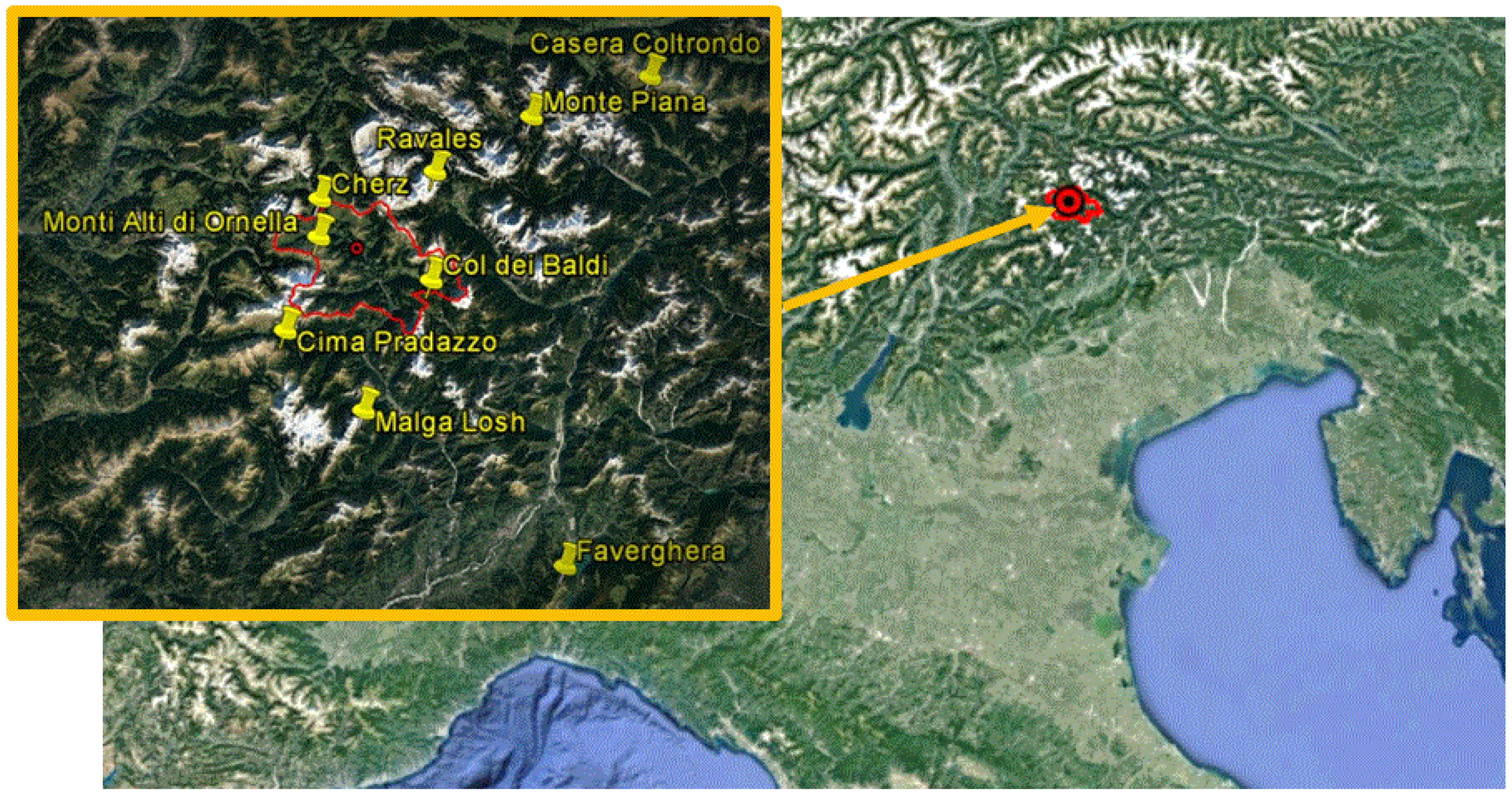
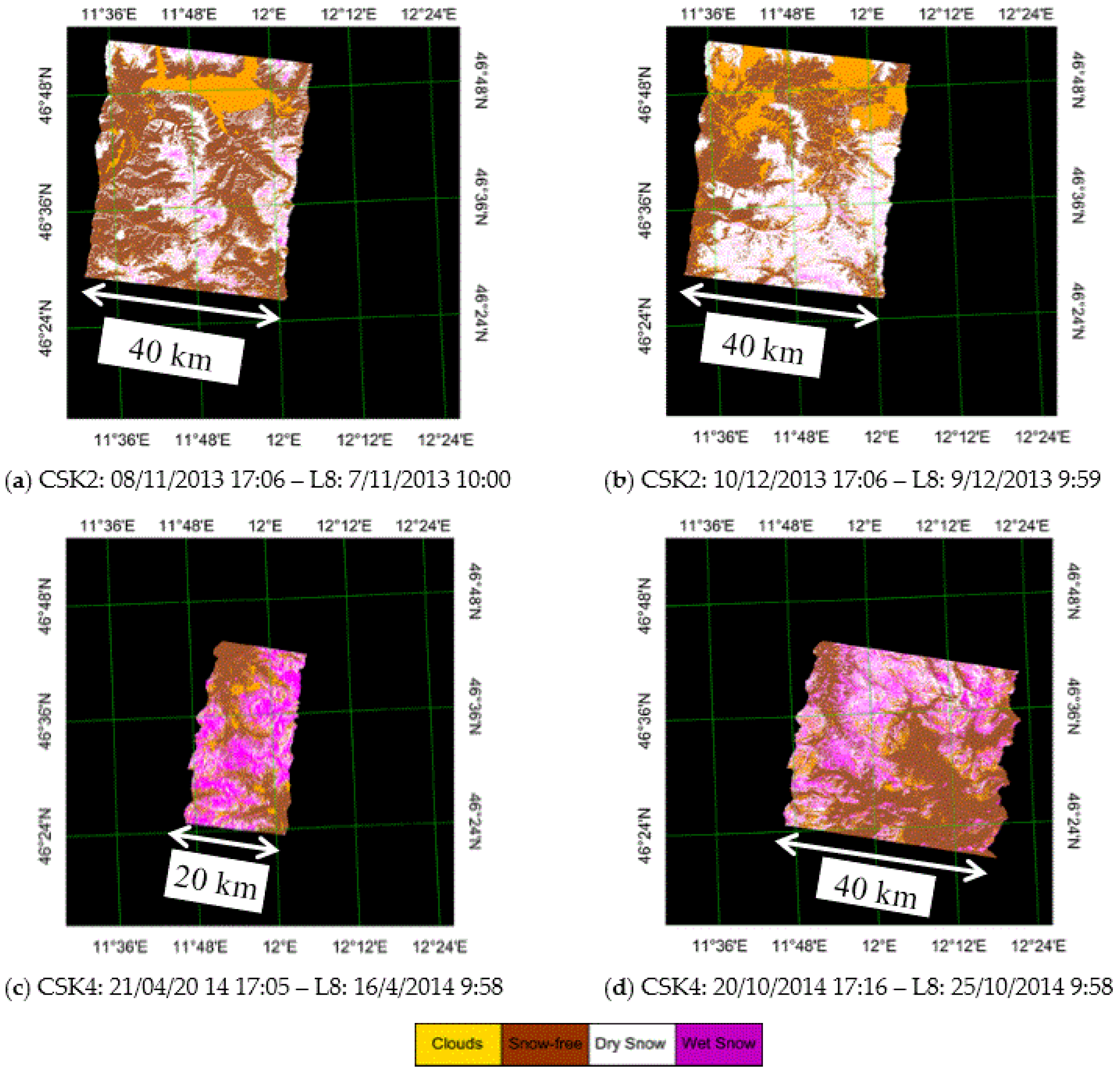

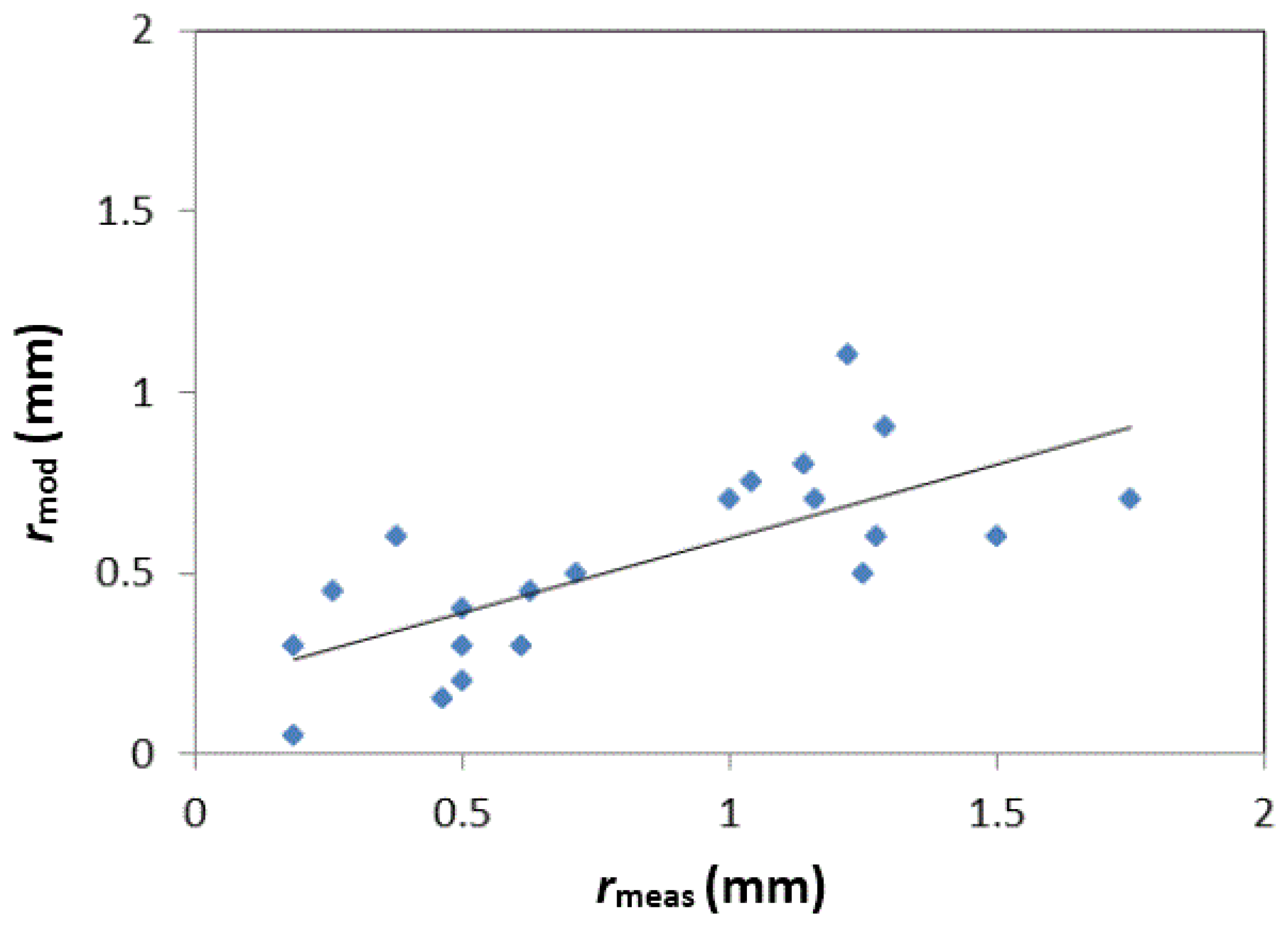
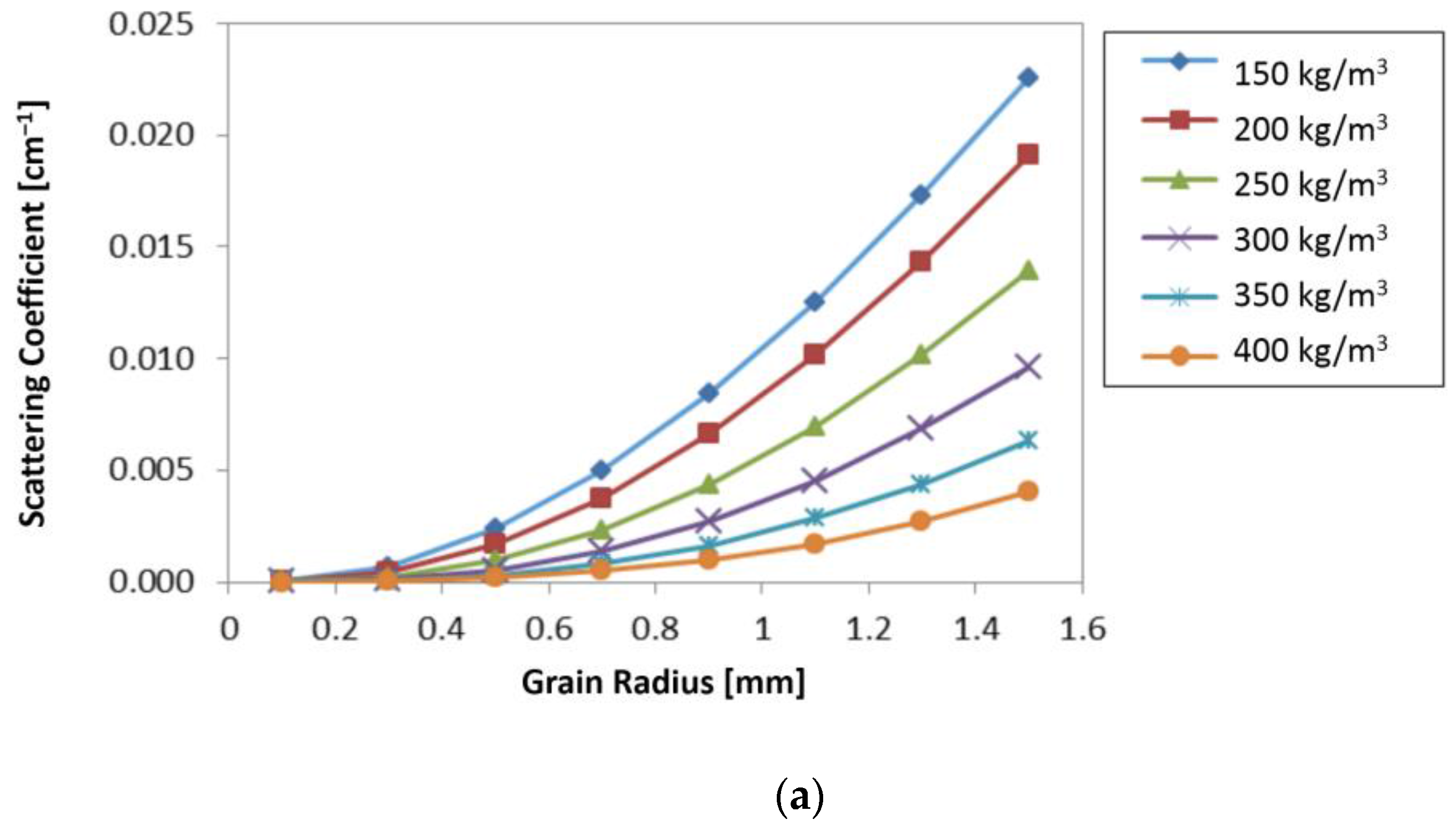
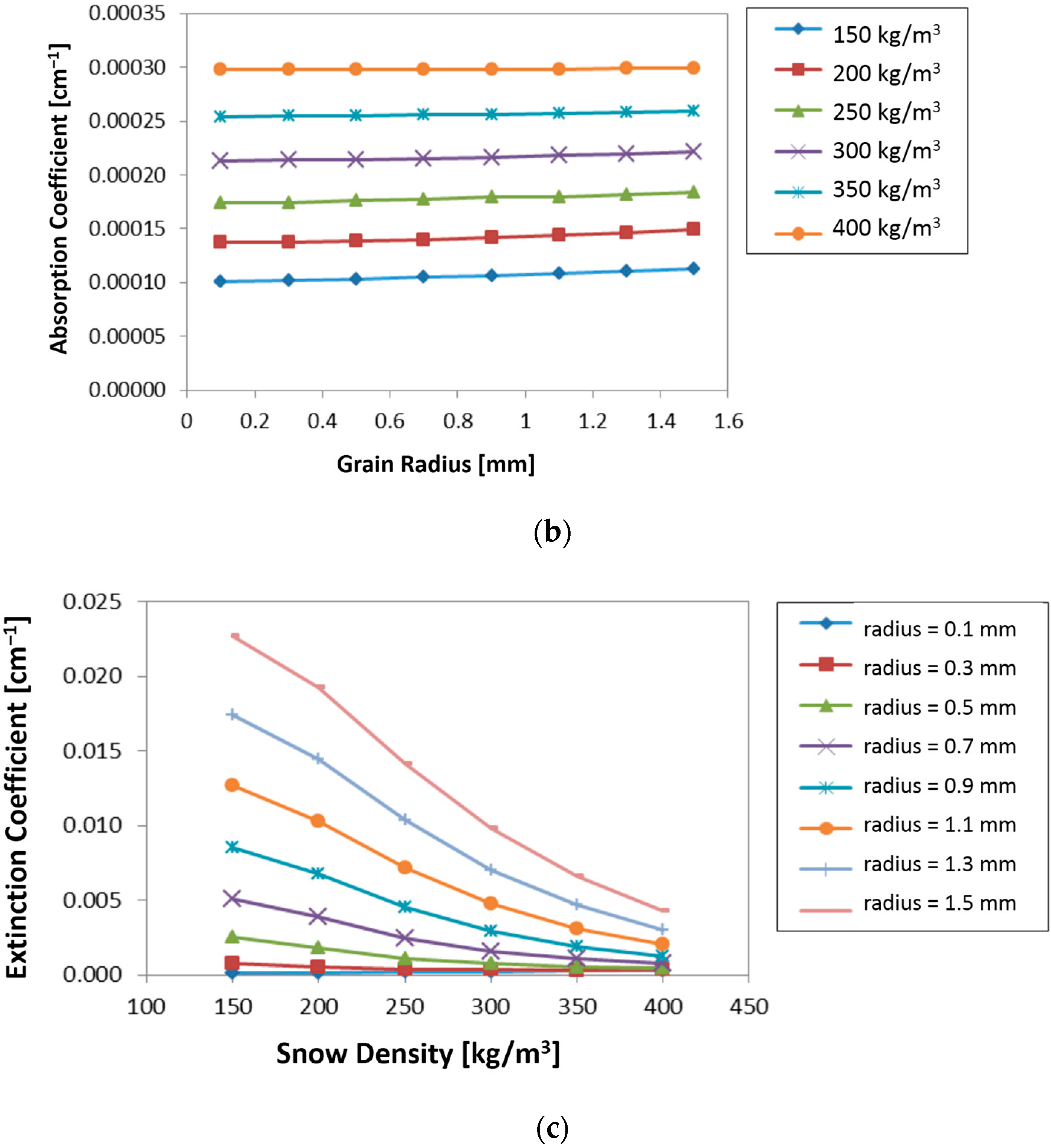


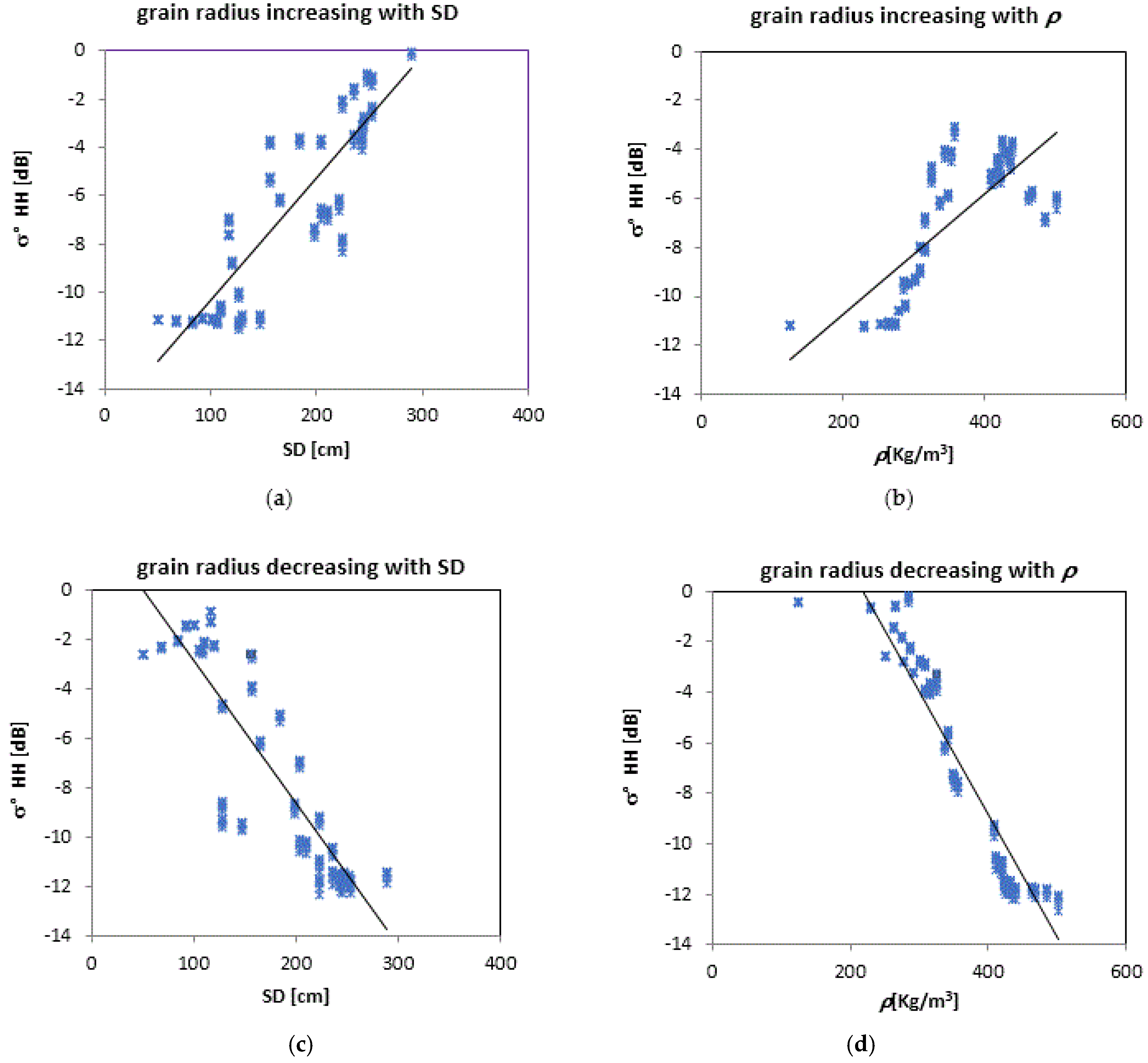
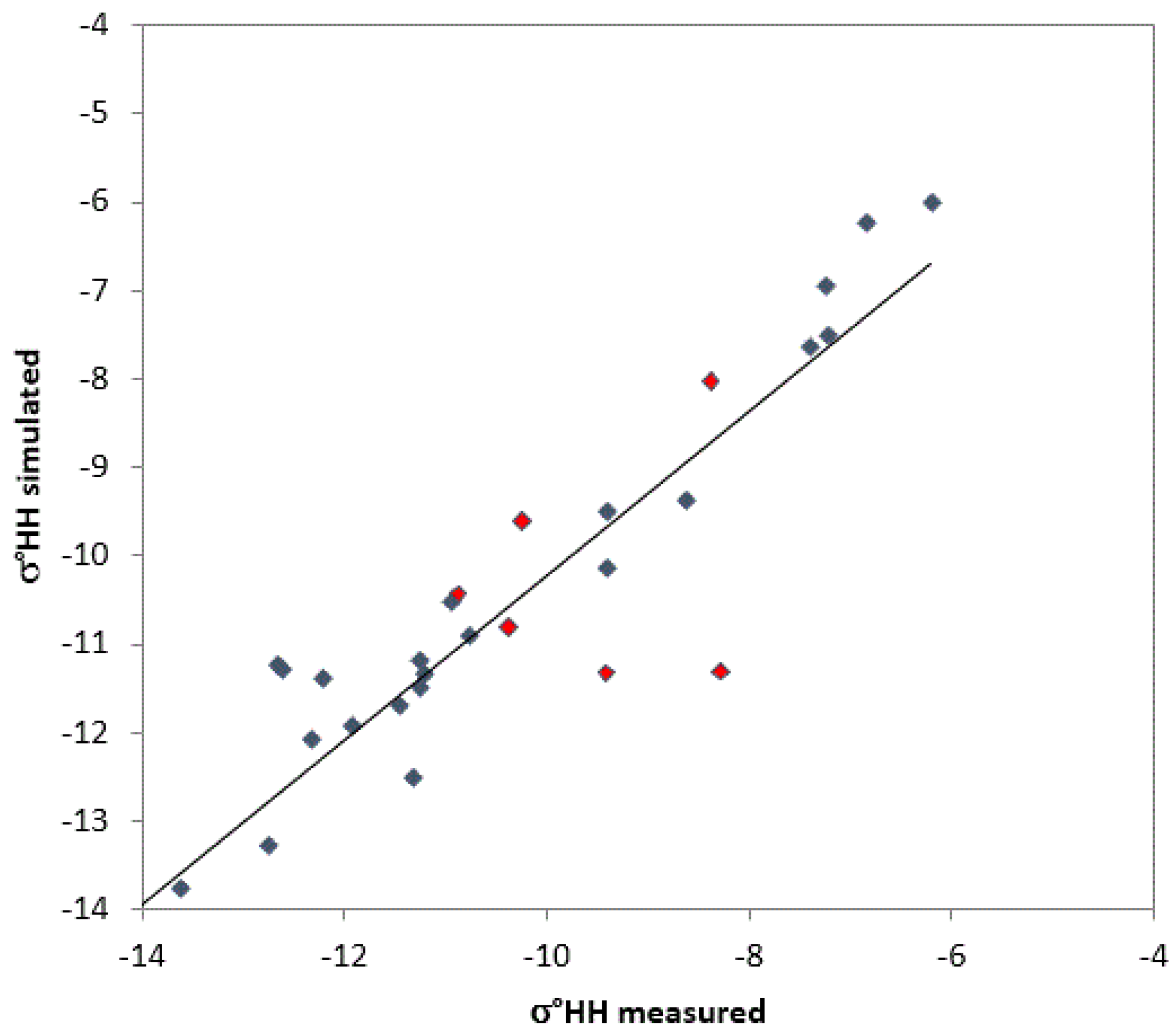
| CSK Images | Reference CSK Images | L8 Images |
|---|---|---|
| CSK2 08/11/2013 – 17:06 | CSK2 24/09/2012 | 07/11/2013 – 10:00 |
| CSK2 10/12/2013 – 17:06 | CSK2 24/09/2012 | 09/12/2013 – 9:59 |
| CSK4 21/04/2014 – 17:05 | CSK4 19/07/2012 | 16/04/2014 – 9:58 |
| CSK4 20/10/2014 – 17:16 | CSK4 19/07/2012 | 25/10/2014 – 9:58 |
| Snow Parameters | Min | Max |
|---|---|---|
| Snow Density (ρ, kg/m3) | 200 | 350 |
| Snow Depth (SD, cm) | 40 | 200 |
| Grain Radius (r, mm) | 0.05 | 1.5 |
| Tsnow (K) | 230 | 273 |
| Incidence angle (θ, °) | ≅33 | |
| Soil Parameters | ||
| Soil permittivity | 6 + j2 | |
| Height standard deviation (cm) | 0.5 | |
© 2017 by the authors; licensee MDPI, Basel, Switzerland. This article is an open access article distributed under the terms and conditions of the Creative Commons Attribution (CC-BY) license (http://creativecommons.org/licenses/by/4.0/).
Share and Cite
Paloscia, S.; Pettinato, S.; Santi, E.; Valt, M. COSMO-SkyMed Image Investigation of Snow Features in Alpine Environment. Sensors 2017, 17, 84. https://doi.org/10.3390/s17010084
Paloscia S, Pettinato S, Santi E, Valt M. COSMO-SkyMed Image Investigation of Snow Features in Alpine Environment. Sensors. 2017; 17(1):84. https://doi.org/10.3390/s17010084
Chicago/Turabian StylePaloscia, Simonetta, Simone Pettinato, Emanuele Santi, and Mauro Valt. 2017. "COSMO-SkyMed Image Investigation of Snow Features in Alpine Environment" Sensors 17, no. 1: 84. https://doi.org/10.3390/s17010084






